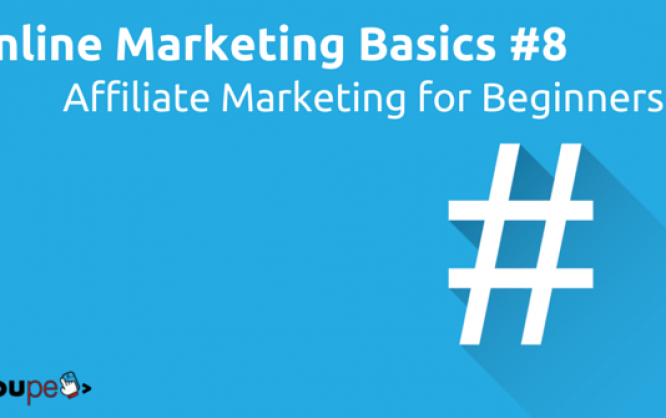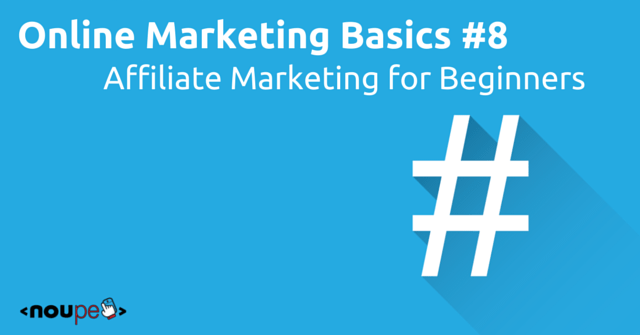Online Marketing Basics #8: Affiliate Marketing for Beginners

In part 8 of our Online Marketing Series, we will talk about affiliate marketing. This type of marketing can be a powerful tool – especially for sales people. To figure out what it is and how to use it, this post will answer these questions: What exactly is affiliate marketing? Who should use it? How is it deployed? What kind of tricky issues should we pay attention to when doing affiliate marketing?

 (Screenshot: Amazon Partnernet)
(Screenshot: Amazon Partnernet)

What is Affiliate Marketing?
Roughly, „to affiliate“ means to associate or to partner with someone. That’s what it’s all about: You tie your partners (the affiliates) to the advertising of your products or services. As always when doing online marketing, you want to direct attention (and drive traffic) to a certain web presence, like your website. So whatever you want to sell – with affiliate marketing, the partners you take on board are called publishers. These publishers promote your product or services on their websites. The goal is to get visitors clicking on your ad or link, respectively, and direct them to your website. Once there, these visitors hopefully perform the desired action (like buying something). If that’s the case, your partner earns a predetermined commission. You can also Use SalesBlink's sales commission calculator to calculate how much revenue you'll make upon every sale. For the easiest way to illustrate it, let’s take a webshop as an example. An online store operator wants to sell his products to a wider group of buyers. Therefore, he starts an affiliate marketing campaign and offers publishers a share of every sale they generate. If a visitor is directed from the publisher’s page to your webshop and makes a purchase, your partner has just earned a commission. The probably best-known affiliate marketing program is online giant Amazon’s Partner Program. A myriad of websites has been created for the sole purpose of being a part of this system. (Screenshot: Amazon Partnernet)
(Screenshot: Amazon Partnernet)
How is Affiliate Marketing Put into Practice?
To make all of this happen, affiliate marketers use a method called cookie tracking. If users click on an ad banner (with a link to your target page) at the publisher’s website the latter stores a cookie on the users’ hard disk. This way, any action that occurs after the click (like purchasing something) can be traced back to and associated with the publisher, making them eligible for a commission. The operator of an affiliate system has to make sure all technologies and processes run error-free. As an online merchant, you have two options: 1. You take care of it yourself using specific software and servers or 2. You join an affiliate network. The benefit of running your own partner program: you only have one-time up-front costs. On the other hand, you need to have the technical know-how, and you have to promote your partner program by yourself. And vice versa, using established affiliate networks like Zanox, affilinet and the like means they will not only take care of all technical processes but also provide you with a wide range of publishers right from the start. That makes promoting your partner program much easier – but comes with a price tag: Many providers ask for a partner program setup fee that can set you back several hundred or even a couple of thousands Euro/Dollar. The actual commission for any conversion can reach as high as 30 percent, and some providers even charge monthly fees. It has to be defined in advance what kind of event would provide a commission. The most common types are „Pay per View“ (generating visitors for a campaign), „Pay per Click“ (often, a specific number of visitors has to be delivered), „Pay per Lead“ (e.g. a prospective client leaves his contacts and orders more information) or „Pay per Sale“ (classic sales commission).Who Could Benefit from Affiliate Marketing?
Affiliate marketing would be most typically deployed when reaching for the consumer market. Indeed, it’s a very popular marketing tool for all kinds of online stores today. Usually, the Pay-per-Sale version is used. However, if the products in question are more complex and need a lot of consulting, Pay-per-Lead is the preferred option. Because there it makes total sense to get in close contact with prospective customers. When it comes to business customers (B2B), affiliate marketing is practical to only a limited extent. It may make sense if your target group is big enough, though. Assuming specific conditions, Pay-per-Lead could work just as well as Pay-per-Sale.What Do You Need to be Aware of in Affiliate Marketing?
This one applies to all online marketing tools: Don’t try a hit or miss approach. Keep your Return on Investment (ROI) in mind. So you’d better explore comprehensively whether affiliate marketing fits your business goals. Some crucial issues are:- Will you meet a proper level of demand for your program? That is, are many people searching for your product/your services?
- What are your business goals? What does your target group look like? Would affiliates be able to help you reach your goals? What kind of customers do you want to reach? Is affiliate marketing the appropriate tool?
- Are there suitable publishers out there? Who could it be: content providers, coupon affiliates or cash back platforms?
- What are your competitors up to? Can you match their affiliate programs?
- Can you charge an appropriate margin to your product/service to make an inhouse effort or the use of an affiliate network pay for itself?
- If you decide to go it alone: Will you reach enough publishers, and therefore program partners?
How to Get Appropriate Publishers
After having answered all questions above and having decided to give affiliate marketing a try, now you have to convince publishers of your capabilities. However, ultimately, it’s not about the sheer number of publishers, but if they would suit your business. The amount of commission is just one factor. A reliable partner would be interested in building a long-term relationship, and a mutually successful campaign. Therefore, you should assess the following:- What is an appropriate commission?
- What kind of incentives could you offer on top? Like appealing starting commissions, rising commissions depending on performance, incentives for high-performing partners?
- Do you have attractive campaign landing pages that can deliver great conversion rates?
- Do you provide appealing advertising banners, coming in all sizes necessary?
- Did you plan the campaign thoroughly, therefore making sure publishers get commissions regularly?
- How do you get the message out to publishers? Like, using the affiliate network, email contact lists, advertising, 3rd party vendors.
What’s Next in our Online Marketing Series?
The next part of the series will discuss banner ads. We will explore what banner advertising is all about and how it works. Furthermore, we will talk about the different types of banner ads and where to insert those ads.Related links
- The Tools of Online Marketing (Basics #1)
- Online-Marketing-Basics #2: 3 Reasons Why Your Website Should Be at the Top of Your List
- Online Marketing Basics #3: Introduction To Social Media Marketing
- Online Marketing Basics #4: Search Engine Optimization (SEO) for Beginners
- Online Marketing Basics #5: Introduction to Search Engine Advertising (SEA) and How Best to Use it
- Online Marketing Basics #6: Introduction to Email Marketing
- Online Marketing Basics #7: Introduction to Video Marketing
